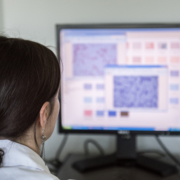Why researchers need to understand more about the small intestinal microbiome
By Prof. Eamonn M. M. Quigley, MD, The Methodist Hospital and Weill Cornell School of Medicine, and Prof. Purna Kashyap, MD, Mayo Clinic
The phrase “gut microbiota” properly refers to the microorganisms living throughout the entire digestive tract, including the mouth and the upper digestive tract, through the length of the small intestine as well as the large intestine. Yet the vast majority of scientific studies on the gut microbiota make conclusions based only on stool samples, meaning that the contributions to health and disease of microorganisms from most of the digestive tract are largely unexplored.
Researchers have established that the microorganisms throughout different parts of the digestive tract vary greatly. In particular, the microorganisms living in the small intestine are fewer in number than those in the colon. They are less diverse, and they change more over time because of their dynamic environment (fluctuations in oxygen, digestive secretions, dietary substrates, among other influences).
The dynamic composition and biologic functions of the small intestinal microbiome in health and disease are mostly unknown. Research has been hampered by the difficulty in obtaining samples from this area of the digestive tract and, in particular, its more distal reaches. Participants in a 2022 ISAPP discussion group argued, however, there are some good reasons to dedicate more effort to investigation of the small intestinal microbiome:
- The small intestine has critical homeostatic functions in relation to nutrient digestion and absorption, immune engagement and interactions with the enteric and central nervous systems, as well as the neuroendocrine system. Each of these could be influenced by microbiota-host interactions. Important locations for these interactions include the gut barrier and mucosa- or gut-associated lymphoid tissue. The nature of microbiota-host interactions in these particular areas needs to be better understood, as they could have implications for systemic host health.
- Diet plays a critical role in symptom generation in many gastrointestinal disorders; it is important to better understand diet-microbe interactions in the gut lumen to determine how the small intestinal microbiome may be contributing to diet-triggered symptoms.
- A disordered small intestinal microbiome is commonly implicated in the pathogenesis of various gastrointestinal and non-gastrointestinal symptoms, from irritable bowel syndrome to Alzheimer’s disease, through the much-disputed concept of small intestinal bacterial overgrowth (SIBO). A precise definition of the normal small intestinal microbiome is a prerequisite to the accurate diagnosis of SIBO and linking it with various disease states.
How can we gain more information on the small intestinal microbiome? Our group tackled the limitations of current definitions and diagnostic methods, noting that this field may be advanced in the near future by new technologies for real-time sampling of intestinal gases and contents. The group discussed optimal methods for the sampling of small intestinal microbes and their metabolic products—noting that a full range of ‘omics technologies applied in well-defined populations could lead to further insights. In the meantime, the gastroenterologists in our group advised restraint in the diagnosis of SIBO and the need to exert caution in identifying it as the cause of symptoms. Clinical progress in this area is best achieved through the application of modern molecular methods to the study of human small intestinal microorganisms.






